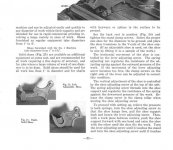Hi all,
I'm a new guy here. Nice to meet you all.
I have a question regarding cylindrical grinding machine.
When I need to cut a cylindrical part using the machine, I had difficulties on getting the cylindrical surface to be even thru out the length.
Although I already adjust the chuck jaw (3-jaw) to get the run out in between out limit which is 26 microns, but still the problem was not improving.
How can I improve on my uneven surface issue?
Does changing to 4-jaw chuck will help me on this?
Thanks for your advice..
I'm a new guy here. Nice to meet you all.
I have a question regarding cylindrical grinding machine.
When I need to cut a cylindrical part using the machine, I had difficulties on getting the cylindrical surface to be even thru out the length.
Although I already adjust the chuck jaw (3-jaw) to get the run out in between out limit which is 26 microns, but still the problem was not improving.
How can I improve on my uneven surface issue?
Does changing to 4-jaw chuck will help me on this?
Thanks for your advice..







